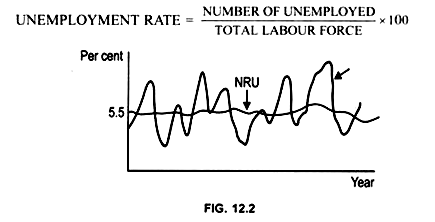NRU is the average level around which the unemployment rate fluctuates.
It is the rate of unemployment that exists even when the labour market is in equilibrium and there is no deficiency of Aggregate Demand.
According to Ruffin and Gregory:
“The NRU is the rate of unemployment arising from normal Labour market frictions that exist when the Labour market is in equilibrium.” NRU refers to frictional and structural unemployment. Full employment is not to be interpreted at zero unemployment. It is a level of employment associated with a NRU, that is, at full employment level, there is always a minimum rate of unemployment which is known as NRU and is denoted by u*.
Reasons of the Rising NRU:
Extended periods of high unemployment rate raises the NRU, known as unemployment hysteresis meaning “coming late”.
Ways in which unemployment hysteresis occurs:
ADVERTISEMENTS:
1. Due to unemployment benefits, the unemployed becomes accustomed not to work. They try to find out about unemployment benefits, how to obtain them and how to spend the day doing odd jobs, or
2. Since they are unemployed for a long time they become discouraged and do not make effort to find a job, or
3. Sometimes employers feel that when the worker is unemployed for a long time he lacks the energy and qualification to work. So the firms are less willing to hire such workers.
According to Mankiw:
ADVERTISEMENTS:
“Higher the unemployment rate, the more unbreakable the vicious circle lengthening unemployment spells.”
Methods for Reducing NRU:
I. Sub-minimum wage to teenagers:
Teenage unemployment form a significant proportion of NRU because they enter and leave job frequently, as the jobs they hold are not attractive. To reduce NRU technical training should be provided to the teenagers which would make holding on to a job more rewarding. As teenagers wages are closer to the minimum wage, by reducing the minimum wage teenager unemployment rate can be reduced.
II. Public Policies:
Public policies tries to reduce NRU by reducing frictional unemployment. Information about job vacancies are collected by the Government employment agencies to match jobs and workers more efficiently, Publicly funded retraining programmes will enable the worker to shift from declining to growing industries. If the programme succeeds at increasing the rate of job finding, then NRU will decrease.
Implications of NRU for public policy:
(i) Any policy which aims at decreasing NRU, must either reduce the rate of job separation (S) or raise the rate of job finding (f) because
U/L = s/s + f If s increases or f decreases U/L will decrease.
(ii) Any policy that affects 5 or f also changes NRU.
ADVERTISEMENTS:
Defect of Public Policies:
Although this model is useful in relating unemployment rate to s and f, it fails to provide an answer to, why there is unemployment and why job finding is not instantaneous.
Thus, while providing unemployment benefits its demerits should be removed because, there is a tradeoff between reducing the distress suffered by the unemployed and the likelihood that higher benefits raise the NRU.

